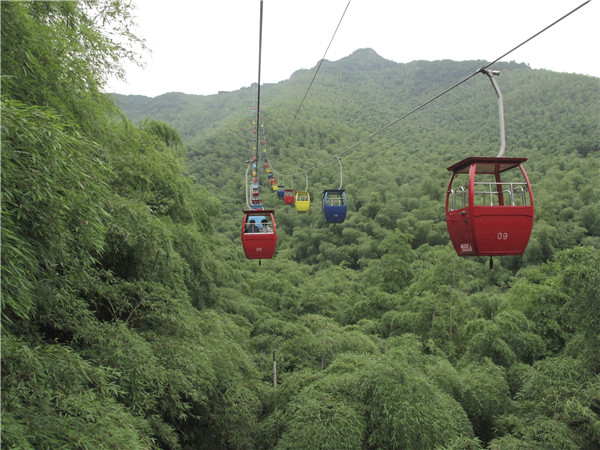 |
|
The cableway connecting the tourist bus station halfway up the Wudi Peak and the mountain top offers a 12-minute pleasant sightseeing trip in the mid air. [Photo by Li Yang/China Daily] |
Bamboo culture and industry
The British Chinese scholar Joseph Terence defines Chinese civilization as "a bamboo civilization." During the Cold War, the West referred to China's "bamboo curtain", and the Soviet Union's "iron curtain".
The evolution of Chinese civilization does have a close connection with bamboo. China has been the main living area of bamboo since ancient times. Many unearthed relics show that the bamboo played an indispensible role in agriculture, transportation, military, culture, arts and people's daily life in Chinese history.
"Without meat, meals are unsavory. Without bamboo, life is tasteless," declares Su Shi, a famous poet in the Song Dynasty (960-1279) and a passionate fan of bamboo culture.
Su writes: "I eat bamboo shoots, live under bamboo tiles, sail in a bamboo boat, burn bamboo to cook, wear clothes made from bamboo surface layers, write on bamboo paper, and walk in bamboo shoes. How can I live without the old friend?"
The Chinese not only used bamboo, but also learned from bamboo. The four plants that ancient Chinese scholars liked most are plum blossom, orchid, bamboo and chrysanthemum for the flowers' purity and bamboo's unyieldingness. Countless ancient pictures, poems and articles are eulogies for bamboo.
Some ethnic minorities in China, such as the Yi, Dai and Jingpo peoples regard bamboo as a totem connecting with their god and their ancestors.
The widespread growth of bamboo in China, from the Yellow River in the north to the coast facing the South China Sea, preserves the soil and water, and was the foundation for the agricultural booming in the region in history.
In the poverty-stricken areas in modern China, bamboo industry has become an important means to lift local people out of poverty, thanks to the fast growing plant and its environmentally friendly property.
Bamboo forests take up about 2.2 million square kilometers in the world. Twenty-five percent is located in China, where more than 500 kinds of bamboo grow, out of the 1,200 kinds in the world. The production value of the bamboo industry in China has risen from about 400 million yuan ($67 million) in 1981 to nearly 200 billion yuan today.
The bamboo museum at the Nanshan Bamboo Forest exhibits thousands of items introducing the bamboo's culture, industry and history in China.
|
|
|
|
|
|
|
|
